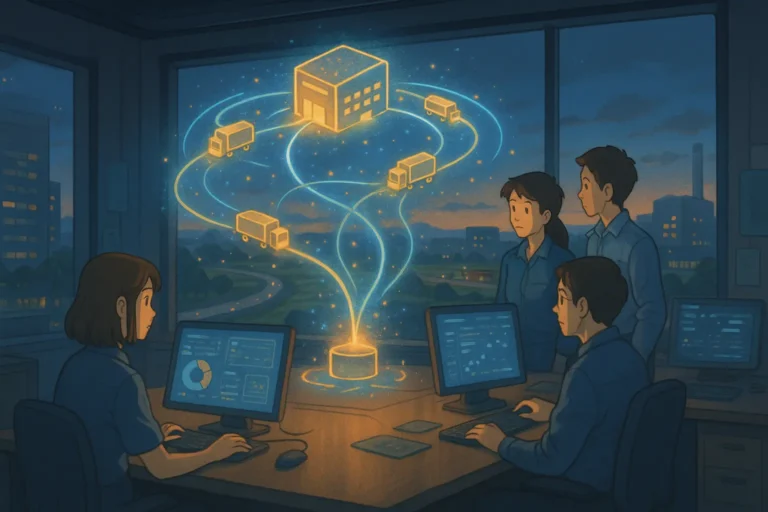
A fire broke out in March 2000 at a Philips semiconductor plant in Albuquerque, New Mexico. It only lasted ten minutes. Flames were quickly put out. Nobody died. No building collapsed. But this small event nearly shut down the global mobile phone industry. This article journals two major supply chain stories. Why did Nokia’s supply chain thrive and Ericsson’s fail?
Philips made the chips powering most of the world’s phones. Two of its biggest clients were Nokia and Ericsson. Both depended on components from that single plant. Yet when the fire broke out and operations ceased at Philip’s semiconductor plant, only one company emerged stronger. The other collapsed.
The difference wasn’t luck. It was leveraging the right supply chain management principles and design.
Continue reading to learn all about how Philips’ factory fire reshaped Nokia’s supply chain and crushed Ericsson’s. More importantly, you will see how African logistics and procurement teams can build crisis-proof supply chains.
Why Did A Small Fire Freeze The World’s Chip Supply?
The Philips’ factory in New Mexico was no ordinary plant. It was a semiconductor hub feeding the electronics industry supply chains. It produced radio-frequency chips essential to mobile phones. When the fire hit, Philips thought recovery would take a week. And there was a good reason for this assumption. There was just one problem, though. It did not take a week.
Smoke had contaminated the clean room, delicate wafers were ruined, and production was ground to a halt. Philips couldn’t make or ship those chips for months. But the warnings came softly. Customers were told everything was fine. And they accepted that verdict. Only Nokia’s supply chain teams refused to relax.
Nokia’s Supply Chain Moved First: Fast, Firm, and Focused
Nokia’s mobile supply chain did not wait for the issue to be resolved. Within hours of hearing about the fire, its component managers flagged the risk. The company did not accept Philips’ one-week promise. They asked questions and sent their engineers to assess the real damage.
While other companies sat still, Nokia formed three crisis management teams. One worked with Philips to move production to other plants in Shanghai and Eindhoven. Another redesigned circuit board to accept alternative chips. A third found new suppliers in Japan and the U.S. The supply chain wasn’t asking for permission.
Such quick reactions and decision-making prowess allowed Nokia’s supply chain to secure raw materials ahead of competitors, change product designs, and keep the factories running. Because Nokia acted fast, it met production targets. It shipped on time. It even gained market share.
Read more: Uncovering Promasidor’s distribution engine that penetrated rural Africa.
Ericsson’s Supply Chain Delayed and Paid the Price
Ericsson’s supply chain didn’t react as quickly. Its managers accepted Philips’ early estimate, which meant they did not escalate the issue. In fact, the company executives didn’t hear about the delay until weeks later. By the time they took action, Nokia had already secured most of the available chips.
Other fabs were booked. Ericsson had no redesign plans, alternate suppliers, or contingency logistics planning. What happened next was inevitable. Production lines stopped. Launches were canceled. And the company lost $1.68 billion in a single year, which It never recovered from. After years of struggling, the company exited the mobile phone business in 2011 and handed it over to Sony.
One wrong decision spelled the beginning of the end for Ericsson’s mobile supply chain.
What Nokia’s Supply Chain Got Right
On paper, anyone could see that Nokia’s supply chain thrived because of good decision-making and the ability to move fast. But it was deeper than that. Here’s what Nokia’s supply chain did that Ericsson’s didn’t and why it matters for supply chains across Africa:
1. Early Action Through Daily Monitoring
Nokia’s logistics teams tracked supplier operations every day. When the fire happened, they noticed it quickly and responded quickly. Their operational risk mitigation culture didn’t punish bad news but rewarded it.
African supply chains must treat delay signals like fire alarms. Regular supplier monitoring (daily, not monthly) is critical.
2. Supply Chain Agility Through Diversification
Nokia’s supply chain did not depend on one supplier. It had alternate sources ready. Even when some chips were only made by Philips, the company had backup plans for similar components and made design changes to fit them.
This is proof that in many cases, single-sourcing risks will destroy unprepared companies. Diversified sourcing benefits include price leverage, speed options, and emergency buffers.
3. Crisis-Ready Leadership
Nokia had clear ownership of crisis response. Top executives got involved, and Philips’ CEO received direct calls from Nokia’s CEO. All these opened factory doors and unlocked resources.
Such leadership reiterates a long-held truth in supply chain management. Crisis management teams must be pre-approved to act. The chain of command must be short. Authority can’t lag behind action.
4. Supplier Partnerships Based on Trust
Nokia treated Philips like a partner, not just a vendor. It offered engineers to help Philips clean the facility. Philips responded by prioritizing Nokia orders. Strong supplier relationships are not built during a disaster. They’re earned before through respect, fairness, and collaboration.
Read more: Inside Lafarge-Africa’s supply chain: Beating FX pressures with local sourcing.
What Did Ericsson’s Supply Chain Get Wrong?
While Nokia thrived, Ericsson suffered. Here is why:
- No Real-Time Visibility: Ericsson didn’t know how bad things were until it was too late. Internal communication was slow. There was no early-warning radar.
- Single Point of Failure: Ericsson relied entirely on Philips for key components. No other vendor had been qualified to step in. When Philip failed, Ericsson was left exposed.
- No Plan B: Ericsson had no alternative component designs. No second supplier contracts. No logistics contingency planning.
- Slow Executive Involvement: Top leadership wasn’t briefed until after the crisis peaked. A sign that decisions lagged behind losses.
- Weak Supplier Collaboration: Ericsson didn’t have deep relationships with Philips. When capacity was tight, Ericsson got what was left after Nokia.
What African Supply Chains Must Do To Avoid Such Failure
To avoid Ericsson’s supply chain disaster, more African supply chains must behave like that of Nokia’s. And this can entail the following:
1. Build Redundancy Into Sourcing
Never depend on one supplier or country. Spread risk across suppliers in different regions.
- Why it works: If one supplier goes down, another fills the gap.
- How to do it: Prequalify backup suppliers even if you don’t use them today.
2. Monitor Daily and Reward Truth
Encourage your teams to report risks early. Create a culture where delay alerts are promoted, not buried.
- Why it works: It gives you time to act while others wait.
- How to do it: Train teams on early signs. Make risk reporting part of performance reviews.
3. Design Products That Can Flex
Work with engineering to create parts that fit multiple chipsets or materials.
- Why it works: It frees you from one-source traps.
- How to do it: Invest in adaptive supply chain strategies that support alternate components.
4. Keep an Inventory Buffer for Critical Components
A lean supply chain has benefits, but avoid running lean on vital parts. Keep emergency stock based on delivery risk, not just price.
- Why it works: It buys time when disaster hits.
- How to do it: Identify items with long lead times or limited suppliers. Buffer them.
5. Build Supplier Trust Before You Need It
Negotiate fair terms. Share forecasts. Visit plants. Treat suppliers like strategic partners.
- Why it works: In a crisis, suppliers will help those they trust first.
- How to do it: Host joint planning sessions. Assign supplier relationship managers.
6. Set Up a Crisis Response Team
Have a cross-functional group ready to act on supply chain emergencies. Give them the authority to make decisions fast.
- Why it works: Speed is everything in supply chain disaster recovery.
- How to do it: Create an internal “disruption team” that meets quarterly to review scenarios.
Read more: Best practices for strategic sourcing in Africa.
African Supply Chains Must Choose Resilience or Regret
The Philips semiconductor disruption was a small event that caused a huge global supply chain crisis. Nokia’s supply chain survived. Ericsson’s supply chain failure wiped out a business. Nokia Ericsson chip shortages came from the same event. One company had a system ready for chaos. The other hoped for calm.
African companies face similar risks every day. Some of these include port delays, customs strikes, cross-border logistics risks, and political shocks. Those risks will stop goods, sales, and cash flow without proactive risk management and responsive logistics management. Nokia won because it planned. Ericsson lost because it waited. The choice is clear.

Obinabo Tochukwu Tabansi is a supply chain digital writer (Content writer & Ghostwriter) helping professionals and business owners across Africa learn from real-world supply chain wins and setbacks and apply proven strategies to their own operations. He also crafts social content for logistics and supply chain companies, turning their solutions and insights into engaging posts that drive visibility and trust.









Your article helped me a lot, is there any more related content? Thanks!